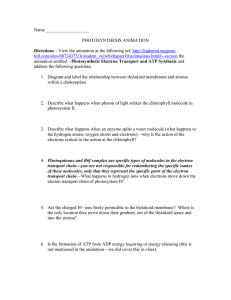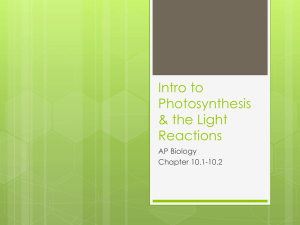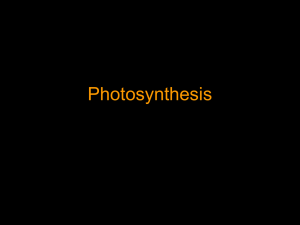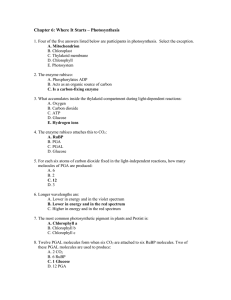File
advertisement
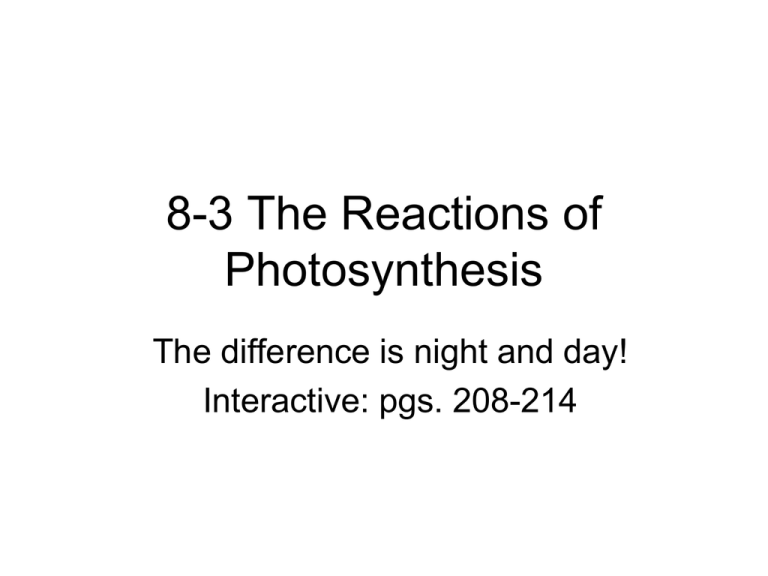
8-3 The Reactions of Photosynthesis The difference is night and day! Interactive: pgs. 208-214 Inside a Chloroplast • Thylakoids – Saclike membranes – Arranged in stacks called grana – Organize the chlorophyll into clusters called photosystems • Stroma – Area outside the thylakoid membrane Chloroplast LEAF CROSS SECTION MESOPHYLL CELL LEAF Mesophyll CHLOROPLAST Intermembrane space Outer membrane Granum Grana Stroma Inner membrane Stroma Thylakoid Thylakoid compartment Electron Carriers (The electron transport chain) • Sunlight gives energy to electrons in the chlorophyll of a plant • NADP+ – A carrier molecule – Can carry 2 high energy electrons and 1 H+ • NADPH – Results from adding 2 electrons – Traps the energy in chemical form • Can be used by chemical reactions in the cell Light Dependent Reactions • In the thylakoid membrane of the chloroplasts • Use energy from light to make O • Converts ADP to ATP • Converts NADP+ to NADPH 5 Steps (Light Dependent Reactions) • 1. Photosystem II- absorbs light and breaks up water • 2. Electron Transport Chain- moves high energy eand transports H+ inside the thylakoid • 3. Photosystem I uses the e- & H+ to turn NADP+ into NADPH • 4. Hydrogen Ion movement makes the outside - and inside +. • 5. ATP formation- H+ move outside the membrane and ATP synthase creates ATP. Light Dependent Reactions Thylakoid compartment (high H+) Light Light Thylakoid membrane Antenna molecules Stroma (low H+) ELECTRON TRANSPORT CHAIN PHOTOSYSTEM II PHOTOSYSTEM I ATP SYNTHASE The Calvin Cycle • Uses ATP and NADPH made during the light dependent reactions • Makes High Energy Sugars like Glucose • Does not require light • Occurs in the Stroma 4 Steps • 6 CO2 molecules + 6 C5 molecules = 12 C3 • The resulting 12 C3 molecules are converted to higher energy molecules by using ATP and NADPH • 2 of the C3 high energy molecules are used to make sugars, lipids, amino acids for metabolism and growth • The remaining 10 C3 molecules are recycled back into 6 C5 molecules to start the cycle again. Factors that Affect the Rate of Photosynthesis • Amount of Water • Temperature – Photosynthetic enzymes function best at 035 degrees C • Light Intensity Review: Photosynthesis uses light energy to make food molecules Chloroplast Light Photosystem II Electron transport chains Photosystem I CALVIN CYCLE Stroma Cellular respiration Cellulose Starch https://www.youtube.com/w atch?v=uixA8ZXx0KU LIGHT REACTIONS CALVIN CYCLE Other organic compounds Quiz Ch.8 1. What type of organism uses light energy to make its own food 2. Which compound is used to release energy to power the cell: ATP or ADP? 3. What is the name of the process that converts light energy into high energy carbohydrates? 4. Write the equation for the above process. (you may use words or chemical formulas) 5. What is the main light absorbing pigment in plants?

